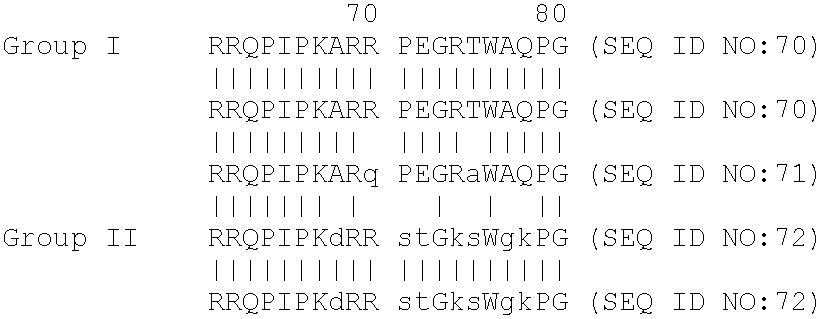Chimera antigen peptide
a technology of antigen peptides and chimeras, applied in the field of antigen peptides, can solve the problems of difficult detection of epitopes comprising a higher structure constructed by amino acid residues which are distant, many problems reported, and serious medical problems
- Summary
- Abstract
- Description
- Claims
- Application Information
AI Technical Summary
Benefits of technology
Problems solved by technology
Method used
Image
Examples
example 1
Epitope Analysis of the Core Region
A peptide having the sequences as set forth in SEQ ID NO: 2 or 3 was synthesized using the peptide synthesizer (Model: 430A) of Applied Biosystems and was subjected to a reverse-phase chromatography to purify the desired peptide. The similarity of the purified peptide with the desired peptide was confirmed by analyzing with an amino acid sequencer.
The peptide was diluted in 0.1 M phosphate buffer, pH 7.5, containing 8 M urea to a concentration of 2.5 .mu.g / ml. The diluted antigen was applied to a multi-module Nunc plate at an amount of 100 .mu.l per well and was allowed to stand for 2 hours at room temperature. After removing the antigen dilution solution, 100 .mu.l per well of the blocking solution (0.5% casein, 0.15 M NaCl, 2.5 mM EDTA, 0.1 M phosphate buffer, pH 7.0) was added and allowed to stand for 2 hours at room temperature to immobilize the antigen on the plate.
To each well was added 100 .mu.l each of the sera of patients with non-A, non-B...
example 2
Epitope Analysis of the NS3 region
In order to obtain fragments having a partial sequence of the NS3 region, the 12 primer DNAs shown in Table 3 were synthesized using the DNA synthesizer (ABI, Model 394A or Milligen / Biosearch, Model 8700).
Using 1 ng of p3N2, a DNA containing the NS3 region (Japanese Unexamined Patent Publication (Kokai) No. 5-84,085), PCR (polymerase chain reaction) was conducted using 100 pmol each of the combination of primers 1F and 1R, 2F and 2R, 3F and 3R, 4F and 4R, SF and 5R, or 6F and 6R. As a result a fragment (the C7-1 fragment) encoding the region corresponding to the HCV polypeptide 1221 to 1281 was obtained from 1F and 1R, a fragment (the C7-2 fragment) encoding the region corresponding to the HCV polypeptide 1265 to 1330 was obtained from 2F and 2R, a fragment (the C7-3 fragment) encoding the region corresponding to the HCV polypeptide 1308 to 1371 was obtained from 3F and 3R, a fragment (the C7-4 fragment) encoding the region corresponding to the HCV ...
example 3
Epitope Analysis of the C14-1-2 Antigen
The purified C14-1-2 peptide was diluted in 0.1 M phosphate buffer, pH 7.5, containing 8 M urea to a concentration of 2.5 .mu.g / ml. The diluted antigen was applied to a multi-module plate of Nunc at an amount of 200 .mu.l per well and allowed to stand at room temperature for 2 hours. After the antigen dilution solution was removed, 200 .mu.l per well of the blocking solution (0.5% casein, 0.15 M NaCl, 2.5 mM EDTA, 0.1 M phosphate buffer, pH 7.0) was added and allowed to stand at room temperature for 2 hours. Thus the antigen was immobilized.
Twenty .mu.l of the sample and 20 .mu.l of the chemically synthesized peptide (0.1 mg / ml) were mixed in equal amounts and allowed to stand at room temperature for 1 hour. Two hundred .mu.l of the sample dilution solution was added thereto, which was then added to the antigen-immobilized plate. After reacting at 30.degree. C. for 1 hour, it was washed and the peroxidase-labelled anti-human IgG (mouse monoclon...
PUM
| Property | Measurement | Unit |
|---|---|---|
| Fraction | aaaaa | aaaaa |
| Fraction | aaaaa | aaaaa |
| Fraction | aaaaa | aaaaa |
Abstract
Description
Claims
Application Information
 Login to View More
Login to View More - R&D
- Intellectual Property
- Life Sciences
- Materials
- Tech Scout
- Unparalleled Data Quality
- Higher Quality Content
- 60% Fewer Hallucinations
Browse by: Latest US Patents, China's latest patents, Technical Efficacy Thesaurus, Application Domain, Technology Topic, Popular Technical Reports.
© 2025 PatSnap. All rights reserved.Legal|Privacy policy|Modern Slavery Act Transparency Statement|Sitemap|About US| Contact US: help@patsnap.com

